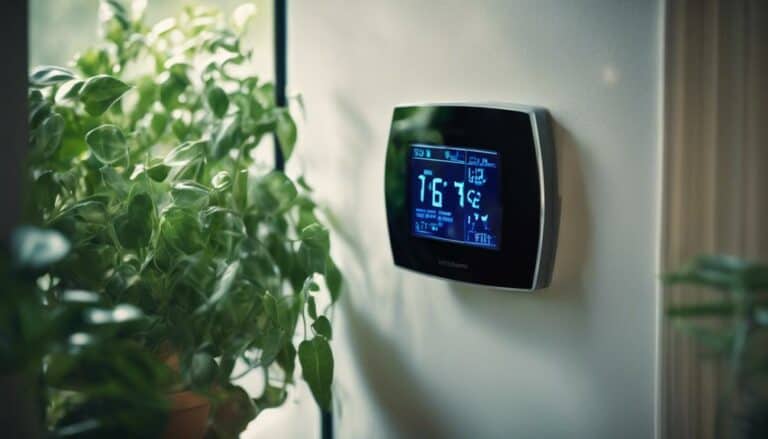Did you know that households in the United States alone are responsible for approximately 20% of the country's total greenhouse gas emissions?
Imagine having a device that not only helps reduce your carbon footprint but also saves you money on energy bills. The eco-friendly smart thermostat ecosystem offers a glimpse into the future of sustainable living practices.
These intelligent devices go beyond just controlling your home's temperature; they adapt to your lifestyle, learn your preferences, and optimize energy consumption.
Ready to explore how these smart thermostats can revolutionize your home and contribute to a greener planet?
Key Takeaways
- Smart thermostats optimize energy consumption for eco-friendly living.
- Reduce carbon footprint and promote sustainable practices.
- Enhance energy efficiency and cost savings with precise control.
- Contribute to a greener future by managing heating and cooling effectively.
The Rise of Eco-Friendly Smart Thermostats
The rise of eco-friendly smart thermostats has revolutionized the way you control and optimize energy consumption in your home. These smart thermostats are designed to enhance energy efficiency, making your heating and cooling practices more sustainable. By allowing precise control over the temperature in different zones of your home, they can potentially save you up to 10% on heating and cooling costs.
With features like personalized schedules and remote access, eco-friendly smart thermostats give you the power to optimize energy usage according to your lifestyle and preferences. They align with green building standards, ensuring that your home meets environmentally friendly criteria.
Embracing these thermostats not only benefits you by providing comfort and convenience but also contributes to a greener future by reducing carbon emissions. Get ready to enjoy a more sustainable and eco-conscious way of managing your home's temperature with these innovative devices.
Environmental Benefits of Smart Thermostats
Embrace a greener lifestyle by harnessing the environmental benefits of smart thermostats, which reduce carbon emissions and promote sustainable heating and cooling practices. Smart thermostats play an important role in minimizing your carbon footprint and supporting sustainable living. By optimizing energy consumption and offering precise climate control, these devices not only save you money but also contribute to a healthier planet. Through remote access and integration with smart home systems, smart thermostats enhance energy efficiency and help you reduce your environmental impact. By aligning with green building standards, they support global efforts in environmental conservation. Take advantage of the energy savings and personalized heating and cooling schedules that smart thermostats provide, and join the movement towards a more sustainable future.
| Environmental Benefits of Smart Thermostats | |
|---|---|
| Reduce Carbon Footprint | Sustainable Living |
| Energy Savings | Remote Access and Energy |
| Integration with Smart Home | Climate Control |
| Optimizing Energy Consumption | Smart Technology |
Energy Efficiency and Optimization

Smart thermostats come packed with energy-saving features that can help you save on your utility bills. They excel at managing peak energy usage by adjusting temperatures based on your habits.
Imagine having a thermostat that optimizes your home's heating and cooling, all while reducing your environmental footprint.
Energy-Saving Features
By harnessing innovative technology, your smart thermostat optimizes energy usage to keep your home comfortable while saving you money. Here are three key ways smart thermostats help you save energy:
- Learning Your Habits: Smart thermostats adjust temperature settings based on your routine, ensuring efficient heating and cooling without waste.
- Utilizing Advanced Sensors: These devices use advanced sensors and machine learning algorithms to avoid unnecessary energy consumption, reducing your carbon footprint.
- Creating Energy-Saving Schedules: With smart thermostats, you can save up to 10% annually on heating and cooling costs by leveraging energy-saving schedules tailored to your occupancy patterns and preferences.
Investing in a smart thermostat not only helps you cut down on utility bills but also contributes to a greener environment by optimizing energy usage effectively.
Peak Usage Management
Peak usage management through smart thermostats optimizes energy consumption efficiently during high-demand periods. Smart thermostats adjust temperature settings to reduce energy usage and costs when it matters most, helping you lower utility bills. By utilizing data-driven strategies to manage peak hours effectively, these devices contribute to a sustainable ecosystem while providing significant energy savings. The energy consumption optimization features in smart thermostats not only make your home more eco-friendly but also lead to reduced environmental impact. With these innovative technologies, you can actively participate in reducing overall energy consumption and costs, all while promoting a greener lifestyle.
| Energy Savings | Sustainable Ecosystem | Lower Utility Bills |
|---|---|---|
| Data-Driven | Eco-Friendly | Reduce Energy Usage |
Remote Control and Monitoring Features
With smart thermostats, you can track your usage data and analyze energy consumption easily. This feature gives you real-time insights to manage your energy effectively.
Imagine optimizing your comfort and saving energy by pre-cooling or pre-heating your home from anywhere!
Usage Data Tracking
Enhance your energy management and sustainability efforts with smart thermostats' usage data tracking feature, allowing real-time insights into your energy consumption patterns and precise control of your heating and cooling systems from anywhere.
- Remote Tracking: Monitor and adjust your heating and cooling systems remotely to optimize energy usage.
- Precise Adjustments: Make specific temperature changes based on occupancy and weather conditions for efficient operation.
- Thorough Reports: Access detailed energy consumption reports to fine-tune your energy management practices.
Energy Consumption Analysis
Improve your energy management and efficiency with smart thermostats' remote control and monitoring features, allowing you to track and adjust your energy consumption from anywhere. By utilizing real-time data and remote control capabilities, you can optimize energy efficiency, leading to lower utility bills and increased sustainability.
These smart devices enable you to make temperature adjustments on-the-go, ensuring comfort while reducing unnecessary energy usage. With insights into energy consumption analysis and energy-saving opportunities, smart thermostats facilitate efficient energy management practices.
Take advantage of these features to not only save on costs but also contribute to a more sustainable lifestyle by actively monitoring and controlling your home's energy usage.
Learning Capabilities for Smart Heating

Utilizing advanced learning capabilities, smart thermostats adapt to your schedule and preferences for efficient temperature control. Here's how they do it:
- Analyzing Occupancy Patterns: Smart thermostats track when your home is typically occupied or empty. By understanding your routines, they adjust heating and cooling settings accordingly, ensuring comfort when needed and conserving energy when you're away.
- Learning Algorithms for Energy Optimization: These devices use sophisticated learning algorithms to optimize energy usage. By anticipating high traffic times and seasonal changes, they make proactive adjustments to maintain a comfortable environment while minimizing energy wastage.
- Enhancing Personalized Comfort: By learning users' habits over time, smart thermostats create personalized temperature settings. This tailored approach not only increases comfort but also enhances energy efficiency by aligning temperature control with your specific needs and preferences.
Integration With Green Smart Homes
Smart thermostats seamlessly integrate with green smart homes, optimizing heating and cooling practices for a reduced carbon footprint. By being part of a green smart home, these devices contribute to energy efficiency, sustainability, and environmental stewardship. Through precise temperature control and energy-saving features, smart thermostats in green smart homes support sustainable living practices and align with global efforts to reduce energy consumption.
This integration not only enhances comfort but also promotes energy conservation, making a significant impact on the environment. Green smart homes leverage the capabilities of smart thermostats to create a more sustainable living environment, where every degree of temperature adjustment matters in the journey towards a greener future. Embracing these technologies in your home not only benefits you but also supports a larger cause of sustainable living and responsible energy usage.
Impact on Energy Consumption

By understanding your habits, smart thermostats efficiently adjust temperature settings to save you up to 10% on annual heating and cooling costs. Here's how they impact energy consumption:
- Optimizing Energy Consumption: Smart thermostats learn your behavior patterns and preferences, automatically adjusting the temperature to guarantee comfort while minimizing energy usage.
- Reducing Energy Waste: By avoiding unnecessary heating or cooling when you're not at home or during inactive hours, smart thermostats help reduce energy waste and lower utility bills.
- Significant Reductions in Carbon Emissions: Through advanced sensors and algorithms that provide precise temperature control, smart thermostats contribute to significant reductions in carbon emissions, aiding in the global effort towards energy efficiency.
With their ability to help homeowners reduce their carbon footprint, achieve energy savings, and promote energy efficiency, smart thermostats are a critical component in creating a more sustainable and eco-friendly living environment.
Building a Sustainable Climate Ecosystem
Creating a sustainable climate ecosystem involves integrating smart thermostats to optimize energy usage and promote environmentally friendly heating and cooling practices. Smart thermostats play an important role in reducing carbon emissions by efficiently managing energy consumption. By adhering to green building standards and sustainability trends, these devices help combat climate change and contribute to a greener future. Their ability to provide personalized schedules for heating and cooling not only enhances energy efficiency but also fosters a sustainable living environment for you.
—
| Benefits of Smart Thermostats | |
|---|---|
| Reduce carbon emissions | Optimize energy usage |
| Support green building standards | Enhance sustainability trends |
| Combat climate change | Promote energy efficiency |
Frequently Asked Questions
How Is a Smart Thermostat Eco Friendly?
A smart thermostat is eco-friendly by learning your habits and adjusting temps efficiently, cutting energy waste. You save up to 10% on bills, reduce carbon emissions. It's like having a green guardian for your home's comfort and the planet.
Is It Cheaper to Leave Your Thermostat at One Temperature?
Leaving your thermostat at one temperature can be cheaper by reducing constant adjustments that increase energy use. Consistent settings help save money and maintain efficiency. Smart thermostats can automate this process for even greater savings and comfort.
What Is the Cheapest Temperature to Keep Your House in Winter at Night?
Keeping your house around 60-68°F at night in winter is cheapest. Lowering each degree can save 5% on heating costs. Set it to 68°F while awake, lower it while sleeping or away to save money and energy.
What Is the Eco Mode on My Amazon Thermostat?
Amazon thermostats' Eco Mode optimizes energy use by adjusting temperatures for efficiency. It saves energy by adapting settings during unoccupied times. This feature reduces utility costs and promotes eco-friendly practices. Enjoy comfort while prioritizing sustainability with this convenient setting.
Conclusion
You've learned how eco-friendly smart thermostats are revolutionizing the way we manage energy consumption and reduce our carbon footprint. With advanced features like energy optimization, remote control, and learning capabilities, these devices are essential for creating a sustainable future.
By integrating with smart home systems and promoting eco-conscious behaviors, smart thermostats help homeowners save money on heating and cooling costs while contributing to a greener environment.
Make the switch to a smart thermostat and be a part of the solution for a more sustainable climate ecosystem.

